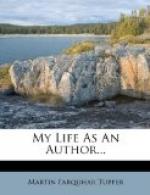Some of our finds were very curious, e.g., we were digging in the black mould of the burnt huts round the wall-foundations (all above ground of said hectagonal wall having since been ruthlessly utilised by parochial economists in making a road across the heath), and found amongst other spoil a little green bronze ring,—which I placed on the finger of our guest of the day, Mrs. Barclay of Bury Hill: oddly enough it had six angles exactly like one of gold she wore as her wedding-guard. Again; we had picked up some pieces of pottery decorated with human finger-tips,—just as modern cooks do with pie-crust; a son of mine said, perhaps we shall find a dog’s foot on some tile,—and just as he said it, up came from the spade precisely what he was guessing at, the large footprint of dog or wolf stamped fifteen centuries ago on the unbaked clay. Again; I was leaving for an hour a labourer in whose industry and honesty I had not the fullest faith. So in order to employ him in my absence, I set him to dig up an old thorn bush and told him to give me when I returned the piece of money he would find under it. To my concealed but his own manifest astonishment, he gave me when I came back a worn large brass of Nero, saying with a scared face, “However could you tell it was there, sir?” I looked wise, and said nothing.
Among the rarest copper coins was one of Carausius (our English Carew), with two heads on it symbolling the ambition of our native usurper to assert empire over East as well as West, and among more treasure-trove was a unique gold coin of Veric,—the Bericus of Tacitus; as also the rare contents of a subterranean potter’s oven, preserved to our day, and yielding several whole vases. Mr. Akerman of numismatic fame told me that out of Rome itself he did not know a richer site for old-world curiosities than Farley; in the course of years we found more than 1200 coins, besides Samian ware, and plenty of common pottery, as well as bronze ornaments, enamelled fibulae, weapons of war, household implements, &c., both of the old British and the Roman, the Anglo-Saxon, and more recent periods; Farley having been a praetorian station on the Ikenild highway. This is quite a relevant episode of my literary antiquariana. As also is another respecting “My Mummy Wheat,”




